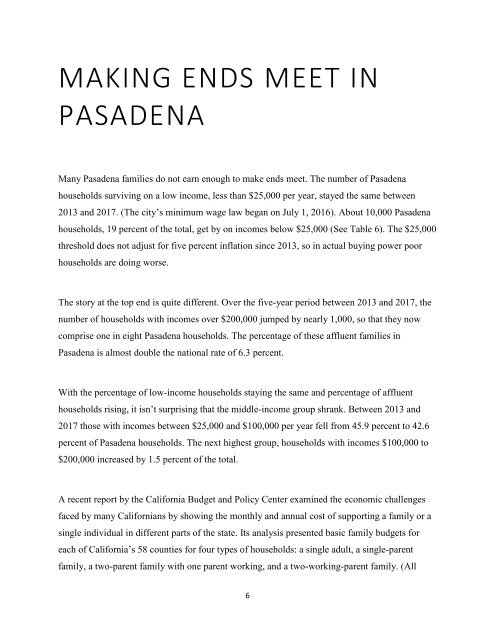Pasadenas-Tale-of-Two-Cities-2019
You also want an ePaper? Increase the reach of your titles
YUMPU automatically turns print PDFs into web optimized ePapers that Google loves.
MAKING ENDS MEET IN<br />
PASADENA<br />
Many Pasadena families do not earn enough to make ends meet. The number <strong>of</strong> Pasadena<br />
households surviving on a low income, less than $25,000 per year, stayed the same between<br />
2013 and 2017. (The city’s minimum wage law began on July 1, 2016). About 10,000 Pasadena<br />
households, 19 percent <strong>of</strong> the total, get by on incomes below $25,000 (See Table 6). The $25,000<br />
threshold does not adjust for five percent inflation since 2013, so in actual buying power poor<br />
households are doing worse.<br />
The story at the top end is quite different. Over the five-year period between 2013 and 2017, the<br />
number <strong>of</strong> households with incomes over $200,000 jumped by nearly 1,000, so that they now<br />
comprise one in eight Pasadena households. The percentage <strong>of</strong> these affluent families in<br />
Pasadena is almost double the national rate <strong>of</strong> 6.3 percent.<br />
With the percentage <strong>of</strong> low-income households staying the same and percentage <strong>of</strong> affluent<br />
households rising, it isn’t surprising that the middle-income group shrank. Between 2013 and<br />
2017 those with incomes between $25,000 and $100,000 per year fell from 45.9 percent to 42.6<br />
percent <strong>of</strong> Pasadena households. The next highest group, households with incomes $100,000 to<br />
$200,000 increased by 1.5 percent <strong>of</strong> the total.<br />
A recent report by the California Budget and Policy Center examined the economic challenges<br />
faced by many Californians by showing the monthly and annual cost <strong>of</strong> supporting a family or a<br />
single individual in different parts <strong>of</strong> the state. Its analysis presented basic family budgets for<br />
each <strong>of</strong> California’s 58 counties for four types <strong>of</strong> households: a single adult, a single-parent<br />
family, a two-parent family with one parent working, and a two-working-parent family. (All<br />
6





